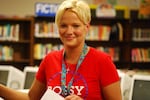Linda Nezbeda wasn't looking for a fight with high school sports.
Her kids are still years away from high school, and she’s well known in the Beaverton School District for another reason: She runs after-school programs for younger children from low-income backgrounds through the nonprofit Beaverton Community for Education.

Linda Nezbeda began Beaverton Community for Education in 2012, to support after-school programs for low-income kids. She has since challenged the Beaverton School District over gender bias in sports.
The Oregonian / OPB
But when Nezbeda started getting bills from the district for using school lights and bathrooms, she resisted.
Her strategy? Get more information. So she called the utilities.
“That was the funniest conversation with like the water company and the electricity company. We measured actual toilet flushes,” Nezbeda said with a laugh. “There were elementary toilets, and it equaled to like 0.002 cents per flush.”
Nezbeda was just getting started.
She wondered who else the district was charging and how much, which led her and other parents to comb through school records. She sensed a pattern. Activities such as dance and cheer, which tend to attract more girls than boys, were being billed a lot, too.
“We just saw primarily the charges were happening to females versus males,” Nezbeda said.
Nezbeda started after-school programs for equity reasons — so that less affluent kids could have opportunities wealthier students had enjoyed for years. Suddenly, she felt she had to take up the mantle for gender equity, too.
Her questions about possible gender bias led her to the high school students who volunteered in the after-school program.
The same way the district charged certain programs more, students said families were charged more for girls in school-related activities — like athletics — than they were for boys. And Nezbeda learned just how spotty the oversight is for sports and activities that seem to be under the school umbrella but are technically separate.
When School Sports And Club Sports Overlap
In 2013, one of Nezbeda’s after-school volunteers, Kaylee Rutherford, was entering ninth grade at Aloha High School. Rutherford wanted to join the girls’ soccer team, so she showed up to an August soccer camp with a check for the coach.

Kaylee Rutherford didn't end up playing soccer at Aloha High School, despite being part of an off-season camp. She is now in her first year at George Fox University.
Rob Manning / OPB
“You paid it directly to the head coach at his truck when he’s out there on the first day,” Rutherford said. “You got a T-shirt with the Aloha name on it.”
Money for camps like that don’t usually go to the school — it goes to separate organizations managed by coaches. Often, they’re tied to private club sports that many Oregon coaches run when they’re not managing high school teams.
That overlap of high school sports and club sports is messy, since one is governed by laws for public schools, and the other answers mainly to market forces.
The dual role has complicated Linda Nezbeda’s efforts to get to the bottom of these apparent disparities between boys and girls in athletics.
Nezbeda started out by pushing Beaverton district officials for information and to look into the costs as possible violations of Title IX, the federal rule mandating equal opportunities based on gender.
But schools tend to apply that rule to facilities and spots on teams.
Pay-To-Play
The Beaverton School District pursued a “self-assessment” with the help of the Oregon Department of Education, an effort that’s resulted in some changes to facility use, including joint use of a batting cage that used to belong exclusively to a baseball team.
But finding information about costs has been tough.
Rising costs are well-known among parents of athletes. School officials say that athletic fees have gone up as state spending on K-12 education has failed to keep up with rising costs.
Districts across Oregon charge pay-to-play fees to fund coaches, equipment and facilities. Playing a high school sport in Beaverton, for example, costs $225.

Pete Lukich in the gym at Beaverton's Sunset High School, where he's director of athletics.
Rob Manning / OPB
Roughly one-fifth of that money goes to cover the cost of athletes who can’t afford to pay, said Sunset High School athletic director Pete Lukich.
“The bottom line on that is no student-athlete will be turned away because they don’t have the funds for that $225,” Lukich said.
But records provided to parents suggest boys tend to get waivers more often than girls. That's certainly not true in every case, but in the Aloha soccer program, for instance, waivers were granted to 70 percent of boys, but to just one-quarter of girls in fall 2016. Football players, an almost exclusively male population, tend to get waivers at higher rates than the girls playing volleyball, according to district records.
In looking into disparate costs, parents found another problem: those off-season leagues and clinics like the soccer camp Kaylee Rutherford attended before her ninth grade year.
“When you think back on it, it does seem kind of sketchy looking at it, but at the time, we came from an atmosphere where that was normal,” said Rutherford, recalling her years playing recreational soccer in Beaverton.
Unspoken Rules
Officially, there’s a bright line between the management of club programs and high school teams, and coaches operating in both worlds are supposed to work hard to ensure they stay separate. For example, coaches can’t require participation in the club to get on the high school team.
Oversight of that rule falls in part, under the jurisdiction of the Oregon School Activities Association, the statewide supervisor of high school athletics.
“Schools and coaches are not able to use what occurred in the summer to determine what happens during the school year,” said OSAA director Pete Weber. “For example, you wouldn’t be able to say, ‘Hey, you have to play on the summer league team, or you can’t play this fall, or this winter.'"
Rutherford said her understanding was that the camp wasn’t absolutely required. But it was run by the high school coach and not every student would make the team. So players followed the unspoken rule.
“It was pretty much recommended that you go to these, because otherwise, you didn’t have that much of a chance,” Rutherford said.
Rutherford didn’t end up playing competitive soccer at Aloha High School. She missed tryouts, and after missing some of the coach’s summer programs, she didn’t think it was worth trying to get her own tryout. Rutherford is now in her first year at George Fox University.
Weber said ensuring students aren’t being unduly pressured is difficult. He agrees with Sunset High School athletic director Pete Lukich, who points out that coaches want to build successful programs, and athletes want to play.
Investigations into whether coaches are requiring participation in outside camps would be based on complaints, and if the participants aren’t complaining, investigations are unlikely.
Cost Differences For Girls And Boys
Linda Nezbeda and other parents wanted to document the costs and the differences for girls. They searched team Facebook pages. They emailed coaches, sometimes posing as parents of athletes to get candid answers.
They amassed a complicated spreadsheet of steep costs, especially for girls. Girls playing soccer at Aloha were charged $450 total; boys paid $265. The difference was even wider between boys and girls playing basketball at Beaverton High. And in a number of cases, the parents found, the money went directly to a business run by the coach, rather than to the school or district.
Their numbers are difficult to verify independently because neither school officials nor the OSAA track them.
Demands on coaches in Class 6A, the conference for Oregon’s largest high schools, are growing as the OSAA experiments with allowing more contact between coaches and players during the part of the school year outside of a sport’s regular season. Full-team practices in the fall are permitted, for instance, for a winter sport such as basketball, whereas for smaller high schools, coaches have to limit their contact to two players at a time.
Sarah Griffin coaches girls’ basketball at Sunset High. As part of her off-season duties, she opened up the gym to her players — and to any girls who wanted to shoot hoops — last fall. That was free, like her summer programs.

Sarah Griffin is the head coach for Sunset High School's girls' basketball team. When she's not coaching, she has another job and is pursuing a degree in school counseling.
Rob Manning / OPB
“I have not charged high school students to participate in summer basketball with us or June basketball,” Griffin said. “However for the youth basketball, the camp that we offer, we do charge.”
Griffin appears to be an example of the proper separation between club and high school rules, according to both district officials and Nezbeda.
The Pressure On Coaches
The Beaverton School District said it is trying to communicate to coaches the rules dividing private club sports from public high school athletics. If coaches charge for clinics or camps and use school property they have to set up an outside organization, rent the school facility and pay for their own insurance. Coaches can use school facilities during certain times under the school’s umbrella — but they have to provide it for free, meaning coaches may have to volunteer their time.
Those are the rules, but Lukich said the reality is that community expectations have expanded to a year-round commitment, while compensation is limited to a three-month stipend. It’s natural that coaches should want to be paid more than that.

Championship banners hang above the Sunset High School gymnasium.
Rob Manning / OPB
“They’re entitled to something potentially, so when people would jump on that and say, ‘They shouldn’t be paid,’ I think there are other parameters that should go into that,” he said.
Lukich and other district officials acknowledge that some coaches earn money by operating in a perceived gray area between club and high school sports.
“They do take their position as being a head coach, and they create these offseason camps,” Nezbeda said. “But then they go and file for-profit business registries, and they then go and charge whatever they want to charge.”
Coaches aren’t under any obligation to share financial information about their club sports with school districts, and districts don’t track how much money student-athletes are paying those outside clubs.
Creating Change Is Difficult
As for why girls may be charged more than boys, Nezbeda and other parents don’t suspect any kind of intentional sexism. They say it’s a historical bias, where more established and popular boys’ sports programs raise more money through booster clubs and higher attendance revenue. So male programs are in a better financial position to bring down costs than female programs are.
Evidence of that stronger fundraising can be seen in facilities as well. For years, Aloha High School’s baseball team had a batting cage, thanks to a fundraising campaign. But it was only available to male baseball players and not to female softball players.
It took time for Beaverton officials to acknowledge the boys’ exclusive use of a school facility was a Title IX violation, but now the Aloha boys’ baseball team shares the cage with the girls’ softball team.
“Title IX is agnostic about where the money comes from,” said David Williams, the Beaverton district's government relations director.
Still, enacting changes is tough.
Nezbeda said the district was slow to schedule time for the softball players. Williams acknowledges there are baseball supporters who aren’t happy that the boys have lost unfettered use of the cages.
“That is a struggle for our passionate supporters,” Williams said. “That’s understandable if they put in the blood, sweat and money to build a facility but it is a district-owned facility.”
Nezbeda argues that the same Title IX rules should apply to programs run by high school coaches, including outside camps. But the evidence that Nezbeda has gathered on costs hasn’t led to big changes. At least not so far.
This is the first of two parts in an OPB report on gender bias and athletics.

